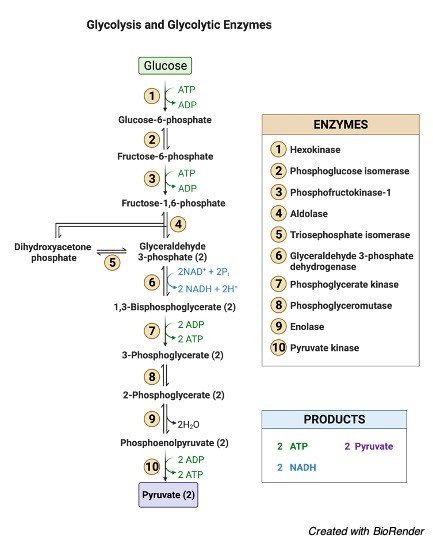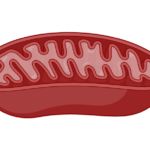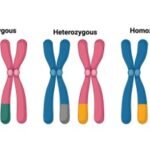Glycolysis – an Overview
The glycolytic pathway delineated the oxidation of glucose to pyruvate.
In this transaction ATP and NADH are generated which provides energy through electron transport chain in mitochondria.
The pathway is also known as Embden-Meyerhof Pathway.
This pathway is universal since it is evident in all the organisms, moreover, it is carried out in the cytosol.
It is the prerequisite step in generation of the energy and various metabolic product.
In aerobic condition, pyruvate is oxidized to CO2, while in the absence of O2, pyruvate is fermented to lactate or ethanol.
Net Reaction: Glucose + 2NAD+ + 2 Pi + 2 ADP = 2 pyruvate + 2 ATP + 2 NADH + 2 H2O
Stage of Glycolysis
The first stage of glycolysis is phosphorylation of glucose molecule under the influence of enzyme hexokinase which converts glucose to glucose-6-phosphate.
In this step, 1 ATP has been used for the conversion.
The second step involves isomerization of the glucose-6- phosphate to fructose-6-phosphate under the influence of the enzyme phosphoglucoisomerase.

In the third step, fructose-6-phosphate is phosphorylated and converted to fructose 1,6- bisphosphate wherein the reaction is influence by phosphofructokinase enzyme.
In this process one ATP molecule has been consumed which dephosphorylates to ADP.
In the fourth step, fructose 1,6- bisphosphate is cleaved by the enzyme aldolase into 2 isomeric molecules of 3 carbon compounds namely Dihydroxy acetone phosphate (DHAP) and 3- phosphoglyceraldehyde.
The above 2 trioses are interconvertible under the influence of enzyme triosephosphate isomerase.
“Glycolysis involves 10 steps that results in conversion of glucose to pyruvate”
In the fifth step, 3- phosphoglyceraldehyde is easily available for further reactions.
In the sixth step, 3- phosphoglyceraldehyde is phosphorylated and oxidised to 1,3- bisphosphoglyceric acid in the presence of enzyme 3-phosphoglyceraldehyde dehydrogenase.
In this reaction, 1 ATP molecule is used while 1 NADH2 molecule is formed.
In the seventh step, 1,3- bisphosphoglyceric acid is dephosphorylated and converted to 3-phosphoglyceric acid by phosphoglyceric kinase.
This reaction leads to formation of 1 ATP molecule by direct synthesis which is also known as direct phosphorylation or substrate phosphorylation.
In total, 2 ATP molecules has been formed out of 2 three carbon substrate.
In the eight step, dephosphorylartion occurs which converts a 3-phosphoglyceric acid to 2- phosphoglyceric acid with the help of phosphoglyceric mutase.
In the ninth stage, dehydration of 2-phophoglyceric acid has been carried out to form 2-phosphoenol pyruvic acid with the help of enzyme enolase.
In the final tenth step, under the influence of pyruvic kinase, 2-phosphoenolpyruvic acid dephosphorylates to pyruvic acid.
In this reaction, ADP phosphorylates to ATP.
Glycolysis: Energy Balance Sheet
• Hexokinase: – 1 ATP
• Phosphofructokinase: – 1 ATP
• GAPDH: +2 NADH
• Phsophoglycerate kinase: +2 ATP
• Pyruvate kinase: +2 ATP
• Total/ molecule of glucose: +2 ATP, +2 NADH
Factors Affecting Glycolysis
A. Hexokinase
It is the first step of glycolysis where hexokinase phosphorylase glucose molecule to glucose-6-phosphate.
This is the first irreversible step and also the rate limiting step.
The rate of conversion of glucose to glucose-6-phosphate depends on the little amount of G6P in the substrate.
If excess amount of G6P accumulates in the cell, a negative feedback will be send for inhibition of hexokinase.
However, G6P is the basic molecule which is involved in various pathways like pentose phosphate shunt and glycogen synthesis along with kreb’s cycle, thus, chances of getting negative feedback is negligible.
B. Phosphofructokinase
Another rate limiting step is with enzyme phosphofructokinase. A sudden spike in AMP/ADP levels activates the enzyme, in contrast, higher ATP levels inhibit it.
In addition to this, feedback inhibition is observed by Citrate which is an intermediate step in TCA.
Moreover, fructose 2,6- bisphosphate is an example of allosteric feed-forward activator where it has positive influence on phosphofructokinase.
C. Fructose-2,6-bisphosphate (F-2,6 –BP)
The action of phosphofructokinase 2 (PFK2) and fructose bisphosphatase 2 (FBPase2) modulated the concentration of F-2,6-BP when glucose levels are low, glucagon level increases.
Thus, to increase the synthesis of the glucose F-2,6-BP is converted to F-6-P and vice versa.
D. Pyruvate Kinase
This is another step past phosphofructokinase step that regulates glycolysis.
Low glucose conditions inhibit the activity of pyruvate kinase by covalent phosphorylation.
An allosteric feedforward activator is after the formation of fructose 1,6 bisphosphate which drives the pyruvate kinase reaction forward.
AMP and ADP are other positive effectors while ATP is a negative effector.
Fate of Pyruvate in Glycolysis
NADH is formed from NAD+ during glycolysis.
The redox balance of the cell has to be maintained for further cycles of glycolysis to continue.
NAD+ can be regenerated by one of the following reactions /pathways:
a. In the absence of O2, pyruvate is converted to lactate or in some yeast or microbes it is converted to ethanol.
b. In the presence of O2, pyruvate is converted to acetyl CoA which enters TCA cycle and gets completely oxidized to CO2 where NAD+ is regenerated by ETC.
Lactate Fermentation
Formation of lactate is catalyzed by lactate dehydrogenase:
CH3-CO-COOH NADH + H+ → CH3-CHOH-COOH + NAD+
Under extreme activity of muscle, oxygen supply cannot cope with the increased demand of the ATP.
Thus, to meet the demand, aerobic glycolysis gets converted to anaerobic glycolysis which leads to increase build-up of lactate in the body causing deep in the pH.
The drop in pH inactivates various enzymes.
Cori Cycle
Due to heavy muscle activity lactate is synthesize in the muscle to regenerate NAD+ from NADH.
However, the muscle cannot afford to use NAD+ to regenerate pyruvate from the lactic acid available.
Thus, it is carried to the liver for gluconeogenesis in the presence of oxygen to form glucose and ultimately pyruvate.
This internal collaboration during extreme muscular activity is known as the Cori cycle.
Ethanol Fermentation
Formation of ethanol catalyzed by 2 enzymes
Pyruvate decarboxylase catalyzes the first irreversible reaction to form acetaldehyde:
CH3-CO-COOH → CH3-CHO + CO2
Acetaldehyde is reduced by alcohol dehydogenase is a reversible reaction:
CH3-CHO + NADH + H+ → CH3CH2OH + NAD+
Ethanol fermentation is used during wine-making
Gluconeogenesis
Gluconeogenesis is the procedure to synthesis glucose from noncarbohydrate precursors including pyruvate, lactate, glycerol and aminoacids.
It is the reverse of the glycolysis. However, there are several irreversible steps of glycolysis which are substituted or bypassed.
The following are few steps which reverse the process-
• Glycerol enters as DHAP by the action of glycerol kinase followed by dehydrogenase.
• Lactate is converted to pyruvate by LDH.
• Aminoacids are converted to either pyruvate or oxaloacetate prior to gluconeogenesis.
Regulation of Gluconeogenesis
It is regulated by phosphofructokinase. This leads to conclude that citrate exhibits as a positive effector while AMP and F-2,6-BP as negative effectors.
In condition where glucose level increase, the level of F-2,6-BP too raises which inhibits gluconeogenesis while glycolysis is favoured and vice versa.
Another important regulatory step is pyruvate carboxylase where acetyl CoA and ATP are positive effectors while AMP/ADP are inhibitors.
Moreover, hormones also regulate the process like insulin impel synthesis and activity of glycolytic enzymes in contrast glucagon starts up the gluconeogenic enzymes.
Summary of Glycolysis
The glycolytic pathway exhibits dual role:
To break glucose to synthesize ATP along with this it provides building blocks for the synthesis of cellular components.
The conversion of glucose to pyruvate is regulated to meet the major cellular requirements.
Most of the steps under physiologic condition are reversible except one catalyse by hexokinase, phosphofructokinase and pyruvate kinase.
High level of ATP and citrate are the inhibitor of phosphofructokinase while AMP and fructose 2,6- bisphosphate are activators.
Glucose 6- phosphate inhibits hexokinase which accumulates when phosphofructokinase is inactive.
Pyruvate kinase are inhibited by ATP and allosteric alanine while its activity reaches peak when the glycolytic intermediates accumulate.
Mitochondrial Electron Transport Chain : Cellular Respiration
Glycolysis Citations
- Dysregulated glycolysis as an oncogenic event. Cell Mol Life Sci . 2015 May;72(10):1881-92.
- Glycolysis. Dent Items Interest . 1951 May;73(5):518-20.
- Inhibiting glycolysis in tumour cells. Nat Rev Endocrinol . 2018 Jun;14(6):323.
- Glucose, glycolysis, and neurodegenerative diseases. J Cell Physiol . 2020 Nov;235(11):7653-7662.
- Respiratory metabolism: glycolysis, the TCA cycle and mitochondrial electron transport. Curr Opin Plant Biol . 2004 Jun;7(3):254-61.
- Mini-review on glycolysis and cancer. J Cancer Educ . 2013 Sep;28(3):454-7.


